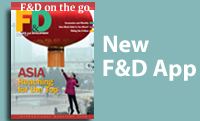Asia’s Resilience
Finance & Development, June 2014, Vol. 51, No. 2
The region survived the global crisis and must now cope with a significant worldwide financial and economic transition

ASIA weathered the global financial crisis and its aftermath with a resilience it built steadily over the past decade. Today, that resilience is again being tested as a significant transition takes place in the global economic and financial landscape.
As the recovery in the major advanced economies strengthens, the end of unconventional monetary easing in these economies is an inevitability. While the prospect of a return to more conventional monetary policy reflects improved economic conditions, it has been accompanied by heightened volatility, with spillovers to the emerging market economies. Asia, with highly open economies and increasingly globally connected financial systems, is not insulated from these external developments. The region will benefit from the global recovery, and its strength and resilience will help it navigate this more volatile international financial environment.
Managing the transition
Almost six years of exceptional monetary accommodation in advanced economies—mainly through large-scale central bank purchases of assets to drive down long-term interest rates—has left the world in uncharted territory. Monetary policy normalization will present a challenging transition. Following the indications of a potential U.S. Federal Reserve scale-back in quantitative easing (its term for unconventional monetary policy) in May 2013, emerging market economies experienced large reversals of capital flows. Within eight months, approximately a quarter of the capital that had flowed into those economies during the preceding four years had reversed. Several economies—in particular those with deficits in both their fiscal and current account positions and high rates of inflation—experienced significant exchange rate depreciation and a decline in equity and bond prices.
Nonetheless, despite increased volatility in capital flows and financial markets, macroeconomic and financial stability in Asia was preserved. Financial intermediation—the linking of savers and borrowers—was not interrupted, and creditworthy households and businesses had continuous access to financing. Economic activity in the region remained broadly unaffected by these volatile financial conditions.
Asia’s ability to intermediate large and volatile capital flows is the result of its strong economic fundamentals and sound banking systems, which have been reinforced by improved governance and risk-management practices and enhanced regulatory and supervisory oversight. Sources of financing are also more diversified following efforts to increase the size and offerings in the capital markets. Economies in the region have generally maintained favorable external positions—with flexible exchange rates, high international reserves, and less reliance on short-term external funding. Many Asian economies also have the policy space and thus the flexibility to implement countercyclical measures.
Since 2009, several Asian economies have also introduced preemptive measures to address the buildup of financial imbalances from capital inflows, which contributed to strong credit growth, high household debt, and rising property prices in the region. Macroprudential measures included limits on maximum loan duration and adjustment of loan-to-value ratios for property purchases, fiscal measures such as higher transfer taxes, and revisions to real property gains taxes.
Policymakers recognized that such preemptive measures would help address domestic vulnerabilities. Efforts have also been directed toward strengthening macroeconomic fundamentals, with greater focus on the current account and fiscal balances. Some economies have eased export rules, such as taxes and currency hedging regulations, while the management of foreign exchange liquidity has been improved to strengthen their external position. Tax and subsidy reforms were also undertaken to reduce government deficits and debt, and improved governance and medium-term fiscal targets enhanced the credibility of the measures.
The policy approach in several Asian economies is gradual, sequenced, and targeted. Given the fragile state of the global economic recovery, this approach will promote orderly adjustments and corrections in the affected sectors. Policymakers can also monitor the impact of these policies and preserve flexibility.
While national policies help strengthen domestic fundamentals, they are insufficient to maintain resilience in an increasingly integrated global economic and financial environment. Regional cooperation has therefore been enhanced, especially in the areas of cross-border surveillance and integrated crisis management to address risks to regional macroeconomic and financial stability preemptively. Multilateral arrangements to support a country in a liquidity crisis, such as the Chiang Mai Initiative Multilateralization, as well as trade financing and settlement arrangements, will improve the region’s ability to weather the more challenging environment. Frameworks are also in place for information sharing and collective policy response when a crisis is imminent.
Unlocking further growth potential
Asia is better prepared to meet the immediate challenges of the current global environment, but it is also focused on raising long-term economic potential.
The region has become an important contributor to global growth. Since 2000, with the exception of the 2009 crisis year, Asia has grown at an annual rate of 7.5 percent, accounting for 44 percent of global growth. Home to 60 percent of the world’s population, the region is a significant source of revenue for many global corporations. Based on Bank Negara Malaysia estimates, the region’s final demand accounted for about 20 percent of global production in 2012, more than doubling since 2000.
In part, this has been achieved through more balanced and diversified sources of growth. The diversification has essentially taken place on two fronts. First, the economies moved from being export led to being more driven by domestic demand. Second, within that domestic demand, the growth drivers shifted from the public to the private sector. As a result of stronger domestic demand in the region, the nations have also diversified their external sectors, shifting from traditional export markets in the major advanced economies to markets within the region. While Asia’s trade with economies outside the region has doubled since 2000, intra-Asia trade has tripled. More than 55 percent of Asia’s exports are now to countries within the region. Similarly, intraregional investment activity has also increased significantly.
In the future, the region’s growth potential will be sustained by several fundamental factors. In particular, Asia’s demographic advantage is a key economic asset. During this decade, a young middle-class population has emerged, and it is growing in number and in affluence. The current middle class of more than 500 million people is projected to exceed 3 billion by 2030 (Kharas and Gertz, 2010). Urbanization and infrastructure development also enhance the region’s growth potential. The increase in consumption demand and greater investment activity will thus anchor the growing importance of domestic demand in Asia.
In addition, Asia’s diversity will continue to support regional economic integration. The region comprises economies at different stages of development that are endowed with a range of rich natural resources. This diversity has enabled businesses and financial institutions to build a comprehensive vertical supply chain whose participants produce a wide range of products and services. Because development needs in the region are vast, there is ample opportunity for further trade and investment linkages, which will garner benefits from outside regional borders.
Importantly, financial institutions and markets will become significantly better integrated in the medium term. This will facilitate more efficient intermediation of funds within Asia through more effective recycling of surplus savings for productive investment. With one of the highest saving rates in the world, Asia has the capacity to meet the region’s vast financing needs with the right institutional arrangements. Efforts toward greater financial integration will also enable further diversification of risk, and contribute to greater stability in the regional financial system. Despite the recent reversal of capital flows, a more developed regional financial system presents additional options for global investors and borrowers and allows for more efficient allocation of financial resources.
To further unlock the region’s growth potential, reforms to generate sustainable, quality, and inclusive growth are also important. Several Asian countries are implementing wide-ranging economic policies to enable participation in more sophisticated links in the value chain and to raise productivity and deliver more inclusive economic growth. Efforts to improve social safety nets, pensions, health care, education, and financial inclusion are being intensified. These efforts contribute to more balanced growth and maintain social cohesion.
At the same time, growing consumption will place demand pressures on limited resources. The policy agenda must therefore address environmental damage, pollution, and climate change—for example, through sustainable financing.
Importantly, growing interdependence will present both benefits and risks. The challenge is to ensure that regional collective action, particularly the institutional arrangements for policy coordination, is evolving in line with the rapid global financial and economic integration.
Asia’s future
Asia’s resilience has withstood a major global financial crisis and its aftermath. As the world transitions to a new environment characterized by moderate growth, slower global trade, and greater uncertainty and volatility, Asia’s response has been preemptive, marked by increased flexibility and greater foresight. A resilient Asia will benefit the global economy by being a vibrant growth center and a stabilizing force in the global financial system. Equally important, beyond economic progress and financial stability, Asia’s contribution can extend to the global policy landscape with the right representation on global forums.
Reference
Kharas, Homi, and Geoffrey Gertz, 2010, “The New Global Middle Class: A Crossover from West to East,” in China’s Emerging Middle Class: Beyond Economic Transformation, ed. by Cheng Li (Washington: Brookings Institution).





